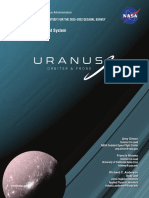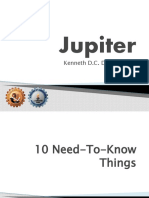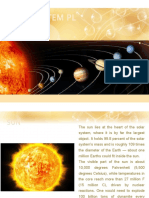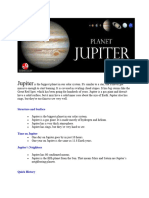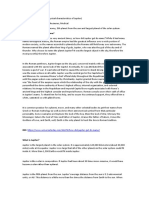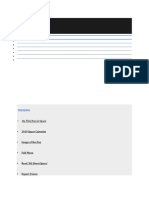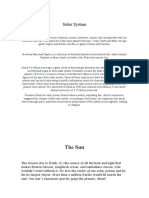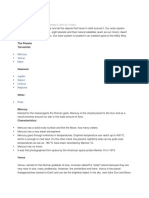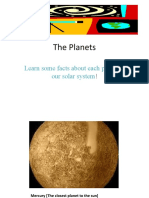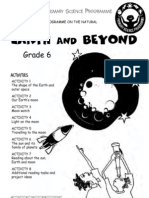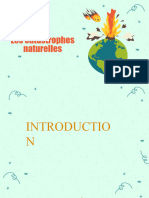Set 45 Writing Jupiter
Set 45 Writing Jupiter
Uploaded by
JamalCopyright:
Available Formats
Set 45 Writing Jupiter
Set 45 Writing Jupiter
Uploaded by
JamalOriginal Title
Copyright
Available Formats
Share this document
Did you find this document useful?
Is this content inappropriate?
Copyright:
Available Formats
Set 45 Writing Jupiter
Set 45 Writing Jupiter
Uploaded by
JamalCopyright:
Available Formats
Anmol
22/05/21
JUPITER is the is largest planet in the solar system, it is also the fifth planet from the sun. Being the largest
planet, it also has the largest diameter coming in at 12,724 km. Amid all the gas planets, Jupiter is the second
densest planet, coming in after Neptune. As Jupiter is a gas planet it has no surface, this is the reason which
explains why the temperature in Jupiter is -145°C! Jupiter has 3 times the mass of the Earth. This gas planet lies
765.48 million km away from the sun and takes a mind-boggling 12 years to orbit the sun once. It is named after
Jupiter, the god of the sky and thunder. In Greek mythology, Jupiter’s other name is Zeus who was the king of
gods. The planet’s astronomical symbol is ♃, it is symbolized as Jupiter/Zeus’s thunderbolt.
Jupiter’s first detailed observations was done on the 7 th of January 1610 by Galileo Galilei. The discovery was
made by a small telescope. Shortly after the discovery, Galileo Galilei discovered many of Jupiter’s 79 moons.
Jupiter’s largest moon Ganymede is even larger than Mercury. Jupiter has been flown past 8 spacecrafts Pioneer
10, Pioneer 11, Voyager 1, Voyager 2, Galileo, Ulysses, Cassini–Huygens and New Horizons. All these
spacecrafts flew past Jupiter and its moons in between the years of 1973 and 2007. With the Earliest being
Pioneer 10 in 1973, and the latest being New Horizons being in 2007.
Jupiter is composed of many types of gas. Just like Saturn, it contains hydrogen, helium, and methane. Its
composition is different to Neptune and Uranus. That is why Jupiter and Saturn are usually referred to as the Gas
Giants, unlike the Neptune and Uranus (Ice Giants). Jupiter has traces of water, ammonia and methane. These
substances are made when oxygen, nitrogen and carbon mix with the mostly hydrogen atmosphere. The planet is
covered in red, brown, yellow, and white stripes of clouds.
The most famous part about Jupiter must be its red spot in its southern hemisphere. This spot is a raging storm
that has been going on for 150 years or maybe even more. The speed of the winds in this spot is 1450 kph. The
diameter of this storm is twice of Earth. There are 4 very faint rings around Jupiter which were discovered on
March 4, 1979. These rings are caused when micro meteors collide with one of Jupiter’s moon. The debris and
dust are brought into orbit and are eventually created into rings. These rings are in different distances from
Jupiter.
Above: Jupiter (2020) showing Jupiter’s red spot, which is a raging storm. The striping colours is caused by
clouds that are mostly made of hydrogen and helium. They only emit certain colours of light.
You might also like
- Uranus Orbiter and Probe - NASADocument59 pagesUranus Orbiter and Probe - NASAAdam ForgieNo ratings yet
- UNIT 1. Universe and Solar SystemDocument7 pagesUNIT 1. Universe and Solar SystemtissusesNo ratings yet
- Custal Project Proposal by SlidesgoDocument47 pagesCustal Project Proposal by SlidesgoAlfredo Zavala0% (1)
- Medical Breakthrough Background by SlidesgoDocument41 pagesMedical Breakthrough Background by SlidesgoYocca AsmaraNo ratings yet
- Facts About The Gas GiantsDocument10 pagesFacts About The Gas GiantsjaneffaNo ratings yet
- What Is So Magnificent About JupiterDocument2 pagesWhat Is So Magnificent About JupiterabhijeetNo ratings yet
- Jupiter Is Massive: EarthDocument6 pagesJupiter Is Massive: EarthAly A. ManansalaNo ratings yet
- The Solar System PDFDocument3 pagesThe Solar System PDFengghomNo ratings yet
- What Do We Know about Jupiter? Astronomy Book for 6 Year Old | Children's Astronomy BooksFrom EverandWhat Do We Know about Jupiter? Astronomy Book for 6 Year Old | Children's Astronomy BooksNo ratings yet
- JupiterDocument5 pagesJupiterGiannis KarozasNo ratings yet
- Jupiter: Kenneth D.C. Delos SantosDocument67 pagesJupiter: Kenneth D.C. Delos SantosKen Dela CruzNo ratings yet
- The Solar System (1)Document40 pagesThe Solar System (1)mhwa.santiagojoaquinalejNo ratings yet
- Science PPT On Stars and Solar System Class 8Document53 pagesScience PPT On Stars and Solar System Class 8P. SURYA ABHINAVNo ratings yet
- Earth & UniverseDocument19 pagesEarth & UniverseCalvinRodgers100% (1)
- SOL AR SYS TEM: Solar SystemDocument9 pagesSOL AR SYS TEM: Solar SystemVasu GuptaNo ratings yet
- JupiterDocument1 pageJupiterapi-287050225No ratings yet
- Space SpaceDocument24 pagesSpace Spacelala209100% (1)
- 1 Solar SystemDocument19 pages1 Solar SystemNitesh BhuraNo ratings yet
- Facts For Planets Extra Credit With ChrisDocument2 pagesFacts For Planets Extra Credit With Chrisapi-205296401No ratings yet
- Unit Six 6. The Solar System 6.1. Family of The Solar System The Solar SystemDocument10 pagesUnit Six 6. The Solar System 6.1. Family of The Solar System The Solar Systemtsehay asratNo ratings yet
- ASTRONOMYDocument18 pagesASTRONOMYrafihaaliu53No ratings yet
- Solar System: By, Manjunath D Nayak Viii B' Roll No. 17Document42 pagesSolar System: By, Manjunath D Nayak Viii B' Roll No. 17Manjusha NayakNo ratings yet
- Solar System PlanetsDocument11 pagesSolar System Planetscemtay2020No ratings yet
- Solar SystemDocument4 pagesSolar Systemvalentine100% (1)
- Inner Planets:: MercuryDocument10 pagesInner Planets:: MercuryRekha Raghavan NandakumarNo ratings yet
- JupiterDocument4 pagesJupiterzelle yi tianNo ratings yet
- Jiyah Na MagandahDocument3 pagesJiyah Na MagandahJiyah Gonzaga BaylonNo ratings yet
- "Improtance of Jupiter and Saturn in The Solar System": Made byDocument10 pages"Improtance of Jupiter and Saturn in The Solar System": Made byKaleem UllahNo ratings yet
- Solar System Facts - A Guide To Things Orbiting Our SunDocument12 pagesSolar System Facts - A Guide To Things Orbiting Our SunSrushti SawantNo ratings yet
- Solar System PresentationDocument61 pagesSolar System PresentationRose Jean Manongsong TiquioNo ratings yet
- JupiterDocument6 pagesJupiterFatimaNo ratings yet
- Topic 7 - The Solar System Up CloseDocument7 pagesTopic 7 - The Solar System Up Closeapi-208538578No ratings yet
- Formation of Neptune:: Interesting Facts About NeptuneDocument1 pageFormation of Neptune:: Interesting Facts About Neptuneapi-281545247No ratings yet
- EarthDocument9 pagesEarthHaider AbbasNo ratings yet
- JupiterDocument1 pageJupitermysta personNo ratings yet
- Jupiter (Redirected From Physical Characteristics of Jupiter)Document4 pagesJupiter (Redirected From Physical Characteristics of Jupiter)Shiela GuevarraNo ratings yet
- All About Our Solar System - RappiDocument8 pagesAll About Our Solar System - RappiLe Yah Dela CruzNo ratings yet
- The Solar SystemDocument15 pagesThe Solar SystemReven Jade PalmaNo ratings yet
- News Tech Spaceflight Science & Astronomy Search For Life Skywatching EntertainmentDocument33 pagesNews Tech Spaceflight Science & Astronomy Search For Life Skywatching EntertainmentdannaalissezabatNo ratings yet
- Jupiter Planet ProfileDocument9 pagesJupiter Planet ProfileJim VazquezNo ratings yet
- Space Physics PresentationDocument15 pagesSpace Physics PresentationKeiraNo ratings yet
- Solar SystemDocument11 pagesSolar Systemfany fanyNo ratings yet
- The Planets TerrestrialDocument5 pagesThe Planets TerrestrialEngr Ghulam MustafaNo ratings yet
- Name and Symbol: Jupiter Is The FifthDocument29 pagesName and Symbol: Jupiter Is The FifthLakshmish GopalNo ratings yet
- Tha PlanetsDocument4 pagesTha Planetslised123No ratings yet
- JupiterDocument18 pagesJupiterCataSalvàNo ratings yet
- PLANETARYDocument6 pagesPLANETARYAlyssa Panuelos FloresNo ratings yet
- What Is The Definition of A ?: PlanetDocument8 pagesWhat Is The Definition of A ?: PlanetWilliam CiferNo ratings yet
- The Planets: Learn Some Facts About Each Planet in Our Solar SystemDocument11 pagesThe Planets: Learn Some Facts About Each Planet in Our Solar SystemFallon TrenterNo ratings yet
- The Solar SystemDocument4 pagesThe Solar SystemAjit PatilNo ratings yet
- Reaction Report (Earth and Its Solar System)Document2 pagesReaction Report (Earth and Its Solar System)Mark Rienzo HingpisNo ratings yet
- Solar System PlanetsDocument6 pagesSolar System PlanetsAbida AzizNo ratings yet
- Chapter 12:solar System: Group MembersDocument11 pagesChapter 12:solar System: Group MembersEdwinNo ratings yet
- Essay About Solar SystemDocument7 pagesEssay About Solar SystemRosechelle HinalNo ratings yet
- Earth ScienceDocument43 pagesEarth ScienceSheng ShengNo ratings yet
- Chapter IV - The Solar SystemDocument5 pagesChapter IV - The Solar SystemmystieNo ratings yet
- DocumentDocument4 pagesDocumentRotsen SebiosNo ratings yet
- Planets of The Solar SystemDocument3 pagesPlanets of The Solar SystemRonel AsuncionNo ratings yet
- The Planets of Our Solar SystemDocument2 pagesThe Planets of Our Solar Systemana trajcevaNo ratings yet
- Set 41 Writing Diary EntryDocument1 pageSet 41 Writing Diary EntryJamalNo ratings yet
- Set 37 Writing Godzilla ReviewDocument1 pageSet 37 Writing Godzilla ReviewJamalNo ratings yet
- My Journey To Health and WellbeingDocument1 pageMy Journey To Health and WellbeingJamalNo ratings yet
- Monaco in FranceDocument13 pagesMonaco in FranceJamalNo ratings yet
- University Agenda and Organizer by SlidesgoDocument48 pagesUniversity Agenda and Organizer by SlidesgoAJA TVNo ratings yet
- Pictopedia QuizDocument18 pagesPictopedia QuizD S PNo ratings yet
- Earth and Beyond (Grade 6 English)Document53 pagesEarth and Beyond (Grade 6 English)Primary Science Programme89% (9)
- Plantilla Powerpoint ArbolesDocument50 pagesPlantilla Powerpoint ArbolesSaúl León PérezNo ratings yet
- DLL - English 5 - Q2 - W2Document13 pagesDLL - English 5 - Q2 - W2Aurea Rose OcañaNo ratings yet
- Arabic Parts, Astrology From The Libra CentreDocument5 pagesArabic Parts, Astrology From The Libra CentreNyusszancska83No ratings yet
- DakfDocument21 pagesDakfSrikanth VankamamidiNo ratings yet
- Human Rights: Here Is Where Your Presentation BeginsDocument39 pagesHuman Rights: Here Is Where Your Presentation BeginsPupung MartinezNo ratings yet
- Sketch Project Proposal by SlidesgoDocument45 pagesSketch Project Proposal by Slidesgomateo DiazNo ratings yet
- Forces and Energy: SampleDocument29 pagesForces and Energy: SamplehuongttNo ratings yet
- MCQ Questions For Class 8 Science Chapter 17 Stars and The Solar System With AnswersDocument12 pagesMCQ Questions For Class 8 Science Chapter 17 Stars and The Solar System With AnswersGopinathan MNo ratings yet
- Proyecto HB Lissette MendozaDocument59 pagesProyecto HB Lissette MendozaLissette Mendoza H.No ratings yet
- The Magic School Bus Gets Lost in Space: Solar System ActivitiesDocument8 pagesThe Magic School Bus Gets Lost in Space: Solar System ActivitiesОксана ГурбінNo ratings yet
- Karma & RelationshipsDocument4 pagesKarma & RelationshipsValentin BadeaNo ratings yet
- 2021-04-24 - Walter Pullen Lunar Lords and The FractalDocument15 pages2021-04-24 - Walter Pullen Lunar Lords and The FractalLuciano AraújoNo ratings yet
- Isometric Proposal by SlidesgoDocument35 pagesIsometric Proposal by SlidesgoAdriána Solano RodríguezNo ratings yet
- The Sky, The Moon,: by Aditi VijayDocument43 pagesThe Sky, The Moon,: by Aditi Vijayhweta173No ratings yet
- 8th Science July Notes L-18 The Universe 2024-25Document7 pages8th Science July Notes L-18 The Universe 2024-25vijaya103laxmiNo ratings yet
- Types of Natural Disasters Class by SlidesgoDocument66 pagesTypes of Natural Disasters Class by SlidesgoAlitiana MitiasoaNo ratings yet
- Horary and Sublord in RetroDocument1 pageHorary and Sublord in RetroProfessorAsim Kumar MishraNo ratings yet
- Geography - A Visual Encyclopedia PDFDocument306 pagesGeography - A Visual Encyclopedia PDFphanlena100% (1)
- 125 Amazing Facts About SpaceDocument8 pages125 Amazing Facts About SpaceSolehah Mohammad RodzeNo ratings yet
- Diwali - A Festival of Lights by SlidesgoDocument55 pagesDiwali - A Festival of Lights by Slidesgoanantbhatnagar232No ratings yet
- International Rock Day LML by SlidesgoDocument55 pagesInternational Rock Day LML by SlidesgoJosé Enrique HerreraNo ratings yet
- Materi Sunda Teks AutobiografiDocument85 pagesMateri Sunda Teks Autobiografigini fitria nurNo ratings yet
- Lesson Plan Choice Board StrategyDocument7 pagesLesson Plan Choice Board StrategyronaleenisraelNo ratings yet
- Schedule Grade 9: S.Y. 2019 - 2020 (EFFECTIVE JULY 22)Document31 pagesSchedule Grade 9: S.Y. 2019 - 2020 (EFFECTIVE JULY 22)Bediones JANo ratings yet
